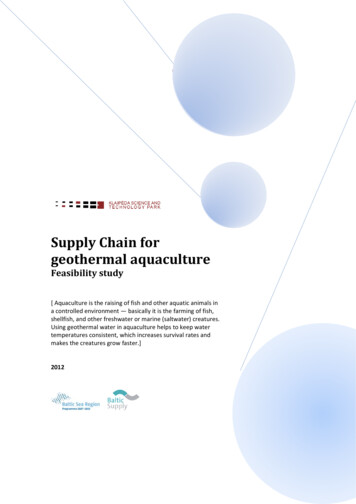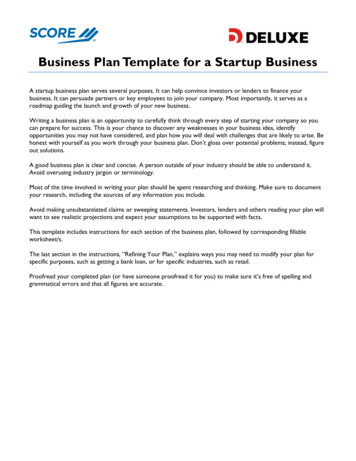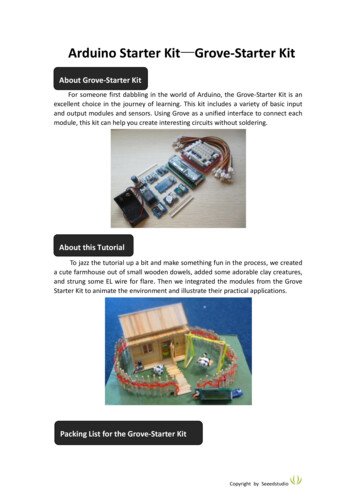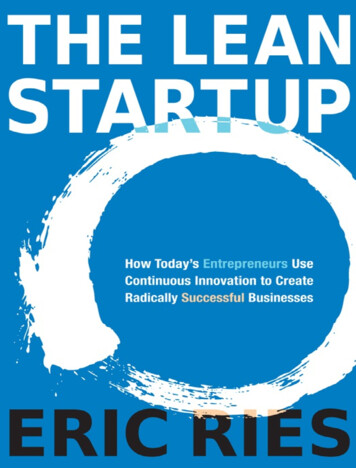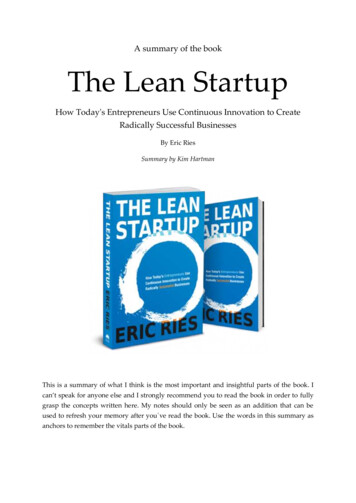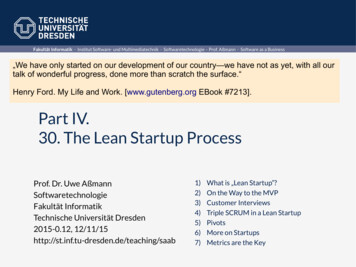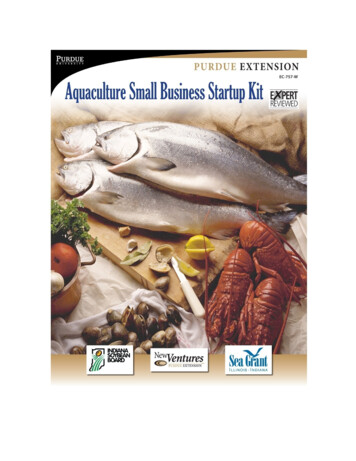
Transcription
iAquaculture Small Business Startup KitMaria I. Marshall, Kwamena Quagrainie, and Shellye ClarkDepartment of Agricultural Economics, Purdue UniversityTable of ContentsI. Starting a New Aquaculture Venture: Doing Your Homework . 1II. An Aquaculture Business – “Good Fit” for me? . 8III. Fundamentals of the Business Plan . 12IV. Understanding Your Market . 16V. A Case Study Using Indiana MarketMaker . 22VI. Aquaculture Production Methods . 25VII. Income Statement . 29VIII. Balance Sheet . 31IX. Startup Kit Budget Worksheets . 34It is the policy of the Purdue University Cooperative Extension Service that all persons have equal opportunity andaccess to its educational programs, services, activities, and facilities without regard to race, religion, color, sex, age,national origin or ancestry, marital status, parental status, sexual orientation, disability or status as a veteran.Purdue University is an Affirmative Action institution. This material may be available in alternative formats.
1I. Starting a New Aquaculture Venture: Doing Your HomeworkIn this new era of renewed entrepreneurship and as producers receive less and less of theconsumer’s dollar, many of you are taking that uncertain but rewarding step toward starting anew venture. Many producers in Indiana are starting specialty food businesses, becomingmembers of new generation cooperatives, or becoming direct marketers of their products. Thispublication describes the first steps of starting an aquaculture business. It includes ActivityWorksheets at the end of each Section to help you through these steps.Research the IndustryWhat do you know about producing fish? The first step in starting a new aquaculture business isto research the industry. You need a good perspective on the industry, your product’s placewithin the industry, and your potential competitors. Your research should provide you withenough information to do a preliminary analysis of your potential customers and competitors.This research will also give you a good start on your business and marketing plans.There are many ways to find information to do your preliminary customer and competitoranalysis. A good way to find some general information is via the Internet, aquacultureassociations, and aquaculture magazines. Aquaculture associations are not only a great way tofind information about the industry, but also a wonderful way to meet people who areproducing fish. Visiting their establishments can be a great source of insight. The IndianaAquaculture Association (www.aquanic.org/iaa/) conducts several workshops during the yearthat you could attend to get information regarding the latest techniques and trends in theindustry. You could also contact your local Purdue University Extension educator and thePurdue University Extension Aquaculture specialist who have extensive sources of information.Research the MarketBefore starting an aquaculture business, you must also determine if there is a market for yourproduct. A market is defined as all the potential buyers of your product. However, consumerinterest alone does not make a market. Your potential buyers must not only be interested inbuying the product but also have the ability to pay your asking price and have access to yourproduct. You will need to determine how big that market is and what segments of thepopulation make up that market. You will need to take an intimate look at your business andidentify the internal and external factors that could be characterized as strengths, weaknesses,opportunities, and threats.
2Preliminary Product and Consumer AnalysisTo do a preliminary product and consumer analysis, you will need to answer the followingquestions: What hole in the market will my product fill? Understanding this is imperative if you are toturn a profit and have long‐term success. An example of a hole in the market would be ifthere was a demand for a fish product from a growing segment of the population in yourarea that is not being met by local producers. If you were able to produce and market thatproduct to that target segment, you would be filling the hole in the market. How is my product different from existing products in the marketplace? In order for yourproduct to succeed, it must provide something to your target customer that is not beingprovided by an existing product, such as convenience, quality, price, and/or a feel goodfactor. A feel‐good factor could be a product attribute that makes the customer feel goodwhen he/she buys it, e.g., people might buy fish from a local producer because it makesthem feel more connected to where their food is coming from and feel better aboutthemselves for buying from local producers. Will I sell my product directly to the end consumer, or will I sell it through a retailer? Theanswer to this question requires information about the customer. If you are going to sellyour product directly to the end consumer, then information about demographics andlifestyle are important. The marketing strategies that you use will be different depending onthe customer you want to attract. A fifty‐year‐old grandmother is a different customer thana thirty‐year‐old mother. Although, both are women and mothers, their need for certainproducts is different because their lifestyles are different. It is also important to know howyour customers will get information about your product and how customers will purchasethe product. In other words, how will you advertise and sell your product? How much will it cost to start my business? What are the equipment and raw materialsrequirements? It is just as important to identify your product’s potential suppliers. Again,aquaculture associations and magazines are a great way to find information on who issupplying the inputs for your product and how much those inputs cost. This is a great wayto find out some of the preliminary capital costs for your business. These are costs that willcome out of your initial investment and that you will not recoup until your business turns aprofit.Preliminary Competitor AnalysisTo do a preliminary competitor analysis, you will need to answer the following questions. How many businesses are selling the same or a similar product in the market I wish toserve?
3 Is there room for more competitors? Especially in a rural area, you want to make sure youknow who your potential competitors will be. There is nothing that can stop your businessfrom developing faster than dipping into the pocket of one of your neighbors. If there isroom for more competitors, why? Perhaps the market is so large that not all potentialcustomers are being served. If so, you should determine if the businesses already in placeare increasing capacity. What are my competitors’ costs? For example, you should get an idea of how much they arepaying for juveniles/fingerlings, feed, transportation, and labor. What type of infrastructure (space and utilities) will my business need? What types of licenses and permits at the federal, state, and local level will I need? What are my competitors’ strengths and weaknesses? Take advantage of your competitor’sweaknesses. Can you avoid your competitor’s pitfalls? What are the strategies pursued byyour competitors? Which would you change and which will you integrate into yourbusiness. These are some of the questions that you should start to think about during thisfirst stage of business development.Suggested ReadingsBaker, Gregory A., Orlen Grunewald, and William D. Gorman. Introduction to Food andAgribusiness Management. Prentice Hall: Upper Saddle River, New Jersey 2002.Iowa State University Extension. Steps to Ag Business Development.WWW.iowaagopportunity.orgRogak, Lisa. The Complete Country Business Guide: Everything You Need To Know To Become ARural Entrepeneur. Williams Hill Publishing: Grafton, New Hampshire 1999.Rowe, R. Barbara and Alma J. Owen.“Getting Started” Working for Yourself. Purdue UniversityCooperative Extension Service.Small Business Administration. Starting Your Business ‐ Your First Steps. http://www.sba.gov
4Activity Worksheet: Self AssessmentNow that you’ve done some preliminary research on the industry, you should take the time toevaluate your finances, business goals, and risk tolerance. There are many questions that youshould ask yourself before embarking on a new aquaculture venture. How you answer thesequestions will give you an indication of whether or not you are ready to start this new business.1. How much are you willing to invest?2. Can you afford to not make a profit from your aquaculture venture for two or three years?3. Will your business require a substantial upfront investment and do you have enough capitalto be the sole owner or will you need to find investors?4. Do you want to work full‐time or part‐time?5. What are your hopes and aspirations for the business? Where do you see yourself in twoyears, five years, and ten years? Do you see your business expanding? If so, do you haveenough capital and infrastructure to do so?
56. Can you deal with the stress of starting a new business? How well can you deal with risk?You should ask yourself how much time and financial and emotional investment you wantto put into this business and how much are you willing to lose.7. Are you prepared to work long, irregular hours and to be on call 24 hours a day?These are questions that should give you some insight into how prepared you are for thisbusiness venture. Several of the sources listed above in the suggested Readings Section onpage 3 have more detailed self‐assessment tests.
6Activity Worksheet: Doing Your Homework1. Why do you think that this is something you would like to do?2. How do you intend to operate this business?A. Hobby?B. Part‐time (supplemental) job?C. Full‐time career?3. What kind of labor is available for your business? Indicate whether full‐time (FT) or Part‐time (PT)A. Self?B. Family and friends?C. Hired hands?4. What fish species do you want to grow and why?5. How much investment do you want to put in this?6. How much profit do you expect from your investment?7. What type of production systems will you be using?A. CageB. PondC. Indoor Tanks8. Do you have experience growing aquatic animals? If ‘No,’ do you intend to learn how togrow aquatic animals?
79. What will be your water source?A. WellB. Stream/CreekC. Rain10. What market coverage are you considering?A. Local/CountyB. State/RegionalC. National11. In what form will you sell your products?A. LiveB. Whole‐on‐iceC. Processed12. How will you get your product to market?A. On‐farm salesB. Deliver to retailersC. Sell to Wholesaler/Distributor
8II. An Aquaculture Business – “Good Fit” for me?Starting a successful aquaculture business requires a lot of thought and time before even a centis spent. Many people worry about whether they have a market for their product of service, butdo not put a lot of thought into how this new business will fit with their current lifestyle or withthe goals they have for their future. This chapter helps you determine how a new aquacultureventure will fit with your personal and business goals.Example of aquaculture being a “Good Fit”Robert loves to raise fish as a hobby and occasionally makes money on the side from it.Several of his friends and neighbors routinely ask him to sell them fish, so Robert isthinking about starting an aquaculture business. He is very busy with his job on thefamily’s hog farm and other activities and knows that if he starts a fish farm he might notbe able to manage other responsibilities or be as active in the family farm. However, hefeels that owning his own business while doing something he really loves will not onlyfulfill his dreams but also provide his family with some extra income.Why Goals Are Important?Begin by determining the reasons you want to start an aquaculture business. Do you want tomake a lot of money? Do you want to be your own boss? Do you simply want to provide a jobfor yourself or someone in your family? Think about your life as a business owner and manager,taking into account all aspects of your life. What benefits will you derive from the business?What are the impacts to your lifestyle? In other words, how will starting and managing a newaquaculture business affect your present job and personal life? Your reasons for starting abusiness will help guide your plan for starting and growing your business. You must think abouthow big you want the business to become. This is important because one of the reasonsbusinesses fail is uncontrolled growth. Consider whether you want the business to remain smallor grow enough to challenge a larger competitor. Is your goal to receive a profit commensuratewith your effort and investment, or is it to earn as much profit as possible?Setting Goals and ObjectivesWhile goals can be broad or general in nature, objectives should be clear and concise. Goals donot have to be specific enough for you to act on, but should give you a future target or list ofthings you want to work on. Objective, however, need to be SMART—specific, measurable,action‐oriented, realistic, and timely—to accomplish the goals you set for your business.
9Example of a Fish Farm Goal and ObjectivesRobert’s goal is to start a fish farm specializing in yellow perch within the next 6 to 12months. Robert’s first objective is to write a business plan within the next 3 months.Robert’s second objective is to contact an attorney, realtor, and his bankers for technicalassistance as he starts his business in the next 6 to 12 months. His third objective is to have 10,000 in sales his first year of business.Action PlansOnce you have identified your objectives, the next step is to break each objective down intoaction plans, or all the steps necessary to achieve that objective. Think of action plans as small,manageable projects. Make sure your action plans are small enough that they can beaccomplished in a few days or a month at most. Work on the most timely goals and objectivesfirst, breaking them down into monthly action plans. Breaking down each objective into actionplans will help you make the daunting task of starting a new aquaculture business manageableand less stressful.Example of a Fish Farm Action PlanRobert has decided to break down his first objective, the business plan, into manageableaction plans. Some of his action plans for the first month are:1.Assess his strengths and weaknesses.2.Write a vision and mission statement.3.Identify potential customer attributes.4.Identify the target market.5.Determine market potential.6.Identify and assess fish farms in the area.7.Research the industry.Starting an aquaculture business takes thought and planning and understanding the reasonsyou want to start an aquaculture business and setting goals are essential to your success.Breaking this process into three steps (goals, objectives, action plans) will make it less dauntingand more manageable.
10Suggested ReadingsScarborough, N.M. and T.W. Zimmer. 2002. Effective Small Business Management: AnEntrepreneurial Approach. Upper Saddle River, NJ: Prentice Hall.Lesonsky, R. ed. 2004. Start Your Own Business: The Only Start‐up Book You’ll Ever Need, 3rd ed.Canada: Entrepreneur Media, Inc.Turner, M.L. 1999. The Unofficial GuideTM to Starting a Small Business. New York, NY: HungryMinds, Inc.
11Activity Worksheet: Goals and Objectives1. List your personal and business goals.2. Break your goals down into objectives for the next year. Remember that they should be‘SMART’— specific, measurable, action‐oriented, realistic, and timely.3. Develop some action plans for the objective above.
12III. Fundamentals of the Business PlanOne of the most important things you can do when starting a business is writing a businessplan. A business plan is an evaluation of your business’ chance of success. It is a game plan formanaging a business successfully, a tool for comparing your actual and targeted results, and awritten summary of your proposed aquaculture business. Last, it is a requirement for a smallbusiness loan. However, the real value of writing a business plan lies in the process of creatingit. Research has shown that those who go through the process of writing a business plan aremore likely to start their business than those who don’t.Use INVenture to write your business plan. You can find it at www.agecon.purdue.edu/planner.It is a web‐based software program that assists you in evaluating your new business. It providesself‐motivated feedback progressively over a series of stages. Each stage represents a section ofthe business plan that should be analyzed in order to accept or reject your proposedaquaculture business.Executive SummaryThe executive summary is the first section of the business plan you see but the last one youwrite. It is a summary of all the relevant parts of the business plan. You should write in laylanguage without industry jargon. In other words, anyone should be able to understand yourentire business concept and your competitive advantage. You should consider it your “elevatorpitch,” and it should therefore be no longer than 2 pages.Mission StatementThe mission statement is the second section of the business plan. Here you would write yourvision of what the company is, what it is to become, and what it stands for. It is the broadestexpression of a company’s purpose and defines the direction in which it will move. A missionstatement is generally a paragraph of approximately 3 to 5 sentences.Business and Industry ProfileThe business and industry profile is the third section of the business plan and can from 3 to 5pages. Here you explicitly write out your goals and objectives. You also provide an industryanalysis that demonstrates your knowledge of the industry and what trends make it possible foryou to enter the market. You should also provide information on the existing and anticipatedprofitability of competing firms.
13You may also want to provide a competitor analysis by doing the following. Provide information on competitors’ market shares, products, and strategies. Demonstrate that your company has an advantage over its competitors. Provide a strengths, weaknesses, opportunities, and threats (SWOT) analysis.Another part of this section is the business strategy, where you explain how you plan to gain acompetitive advantage in the market and what sets your business apart from the competition.You should also demonstrate how you plan to meet goals and objectives in the face ofcompetition and government regulations. This section should also include the image that yourbusiness will project and promote.Marketing StrategyThe fourth section of the business plan is the marketing strategy, which includes a descriptionof your product and the services that you will provide. When you write the description of yourproduct, you should focus on customer benefits and not just a detailed list of the product’sfeatures. This is a way to differentiate your business.In this section you should provide proof that a profitable market exists. You shoulddemonstrate customer interest prove that the target customers need or want the product andare willing and able to pay for it.Plan of OperationThe plan of operation is the fifth section of the business plan. Here you should construct anorganizational chart with key personnel. This shows that you have the right people organized inthe right way. Describe the firm’s form of ownership and any leases, contracts, and otherrelevant agreements pertaining to the operation. You should also include resumes for anyonewith at least a 20% ownership in the business.Financial PlanThe sixth section of the business plan is the financial plan. Your plan should include monthly proforma financial statements for one year and by quarter for each of the next 2‐3 years for thefollowing three statements: Income statement Cash flow statement Balance sheet
14You should include three sets of forecasts: optimistic, most likely, and pessimistic. You shouldalso include a break‐even analysis as part of your financial plan. Your financial plan ought toreflect your ability to repay loans to lenders and to produce adequate returns for investors.Request for FundsIf your business plan is being written for a bank loan or as an investment opportunity, the lastsection of the business plan is the request for funds. You should state the purpose of the loanor investment, the amount requested, and the plans for repayment or cash‐out.A business plan can seem overwhelming. However, remember that the process of thinkingthese things through is more important than the actual words you write. The key thing toremember about the process is that it is iterative. In other words, all the parts inform eachother.
15Activity Worksheet: SWOT AnalysisSWOT stands for Strengths, Weaknesses, Opportunities, and Threats. A SWOT analysis providesyou a great opportunity to assess your competitive advantage and survey the aquacultureindustry to see how you fit in.Strengths and weaknesses are things that are internal to your aquaculture business. Forexample, having several years experience of running a recreational fishing business would be astrength. However, having limited knowledge of marketing may be a weakness.StrengthsExample: several years of experienceWeaknessesExample: no marketing experienceOpportunities and threats are things that are external to your business. In other words, theseare things that you cannot change yourself. For example, increasing ethnic populations could bean opportunity, and increasing federal or state environmental regulations could be a threat.OpportunitiesExample: increasing ethnic populationThreatsExample: increasing environmental regulations
16IV. Understanding Your MarketOne crucial step in the start‐up process and the business plan is understanding the specificproduct needs of the customers targeted by your business. By segmenting the market, you canfind niches that give you a marketing edge over competitors.Undifferentiated versus Differentiated MarketingThere are essentially two basic approaches to marketing—undifferentiated and differentiated.Undifferentiated marketing treats the market as a whole, rather than as individual groups. Itfocuses on the common needs of the entire market, rather than the differences in groupswithin the market. This approach relies heavily on mass marketing and is implemented on thebasis of cost savings to the business. It is generally more successful when the product has massappeal or when there are virtually no competitors.Differentiated marketing considers segments within the market, often working to build loyaltyand encouraging repeat purchases through the consideration of specific customer needs andpreferences. Differentiation through target marketing can create increased total sales becausemarketing efforts are concentrated in specific areas. It can also decrease the cost of production,distribution, and promotion. However, differentiated marketing is not without risk. There isalways the chance that the segments will change in preferences or that a competitor will enterthe same segment. If you have processed or value‐added fish products, this approach tomarketing may be appropriate.Market SegmentsMarket segmentation occurs when a business identifies the potential buyers within a marketwho have similar needs, show similar buyer behavior, and are expected to be the mostreceptive to the product. In order to determine the process a respective customer goes throughto purchase and use the product, you must understand how the target market will use theproduct. It is very important to determine whether potential customers come from theconsumer or business market. For example, most fish farmers in Indiana sell their fish to liveethnic markets. Asians, some Hispanics, and Africans prefer to purchase live fish, so these typesof customers can be your target market. Consumer and business markets have very distinctneeds. The following categories are some of the most common means by which consumermarkets can be segmented.Geography – Are your customers local, regional, national, or international?
17Psychographics – Are there behavioral characteristics that differentiate the customers?Socio‐Cultural Factors – Are there cultural considerations, social connections, or other personalfactors which might shape the customer’s needs, wants, and behavioral patterns?Demography – Are the customers old, young, male, female, low income, or high income?Suppose you want to segment the live market within the fish retail business, the followingquestions would help you to serve the customers in that market.¾ Industry – Do the customers’ needs differ across the fish retail business?¾ Geography – Do the customers in different regions (Asia, Africa, Latin America) havedifferent needs?¾ Purchasing – Who in the business is involved in purchasing live fish? Which factorsinfluence their decisions? What is their background and knowledge with respect to live fish?¾ Company – What are company buying policies and procedures, financial constraints, andtiming of purchases?You should answer the following questions for each market segment, regardless of whether thebusiness is in the consumer or supply market:¾ Is the segment viable? Can we profit from it? Who are the other suppliers of fish?¾ Is the segment accessible? How easy is it to get into this segment of the fish market?¾ Is the segment measurable? Can I obtain realistic data to consider its potential, e.g.,how much live fish is purchased per week or month?After identifying the potential segments within the market, you should look at a number ofthem before making a final decision on which to target. Chicago and many of the major townswithin Indiana have fish retail markets and ethnic stores that sell live fish. It is important topinpoint the benefits that the targeted customers are seeking, such as quality, low price,convenience, availability, status, etc. You must ask questions such as the following.¾ What are the features that are considered basic that all customers expect of the productand/or service?¾ What are features of products and/or services in the industry that help customersdifferentiate between similar products and/or services?¾ What are features of the products and/or services in the industry that energizecustomers to make immediate judgments about purchasing the product and/or service?
18¾ What frustrates customers about the existing product and/or service choices?¾ What key feature is missing from the existing product and/or service choices?After determining the benefits your targeted customers would seek from your product, it isessential to design your product to meet those specific needs and preferences. You shoulddevelop a separate marketing plan for each targeted group to meet their needs andexpectations of your product.It is important to understand how your product can create value for your customer. Thefollowing four questions will help your determine if your product and/or service will indeed,create value.¾ Will my product and/or service provide an economic gain for the customer?¾ Will my product and /or service provide a better price‐performance balance thancurrent products and/or services?¾ Will customers perceive a benefit from my product and/or service that current productsand/or services don’t have?¾ Will customers obtain emotional benefits from my product and/or service that otherproducts don’t provide?In addition to understanding the segmentation categories listed above, you can do thefollowing to assist in segmenting your market.¾ Visit fish retail stores in some Indiana cities and Chicago, if possible.¾ Contact other aquaculture farmers serving a similar market or key trade‐end users.¾ Watch what works for key competitors, borrowing the successful elements of theirmarketing strategy while adding other unique marketing techniques to ensure productdifferentiation.¾ Read aquaculture trade and association publications, basic research publications, andgovernment publications.Aquaculture Marketing ScenariosMarketing strategies differ depending on the species of fish. Largemouth bass, yellow perch,and hybrid striped bass have different customer markets, distribution systems, and processingmethods. Effective marketing methods for these species are listed below.
19Largemouth Bass¾ Live for pond stocking (recreational sport fishing)¾ Live for the live fish retail markets, especially Asian storesYellow Perch¾ Processed or value‐added and sold to grocery wholesalers, food service distributors, ordirectly to the public¾ Processed into whole‐dressed fresh‐on‐ice, or filleted, fresh on ice, frozen, breadedHybrid Striped Bass¾ Live for pond stocking (recreational sport fishing)¾ Live for the live fish retail markets, especially Asian stores¾ Processed or value‐added and sold to grocery wholesalers, food service distributors, ordirectly to the public¾ Processed into whole‐dressed fresh‐on‐ice, or filleted, fresh on ice, frozen, breadedAssessing Your Sales PotentialThe first step in assessing sales potential is determining your potential market. Your potentialmarket is all the consumers
Startup Kit Budget Worksheets . 34 It is the policy of the Purdue University Cooperative Extension Service that all persons have equal opportunity and access to its educational programs, services, activities, and faci


